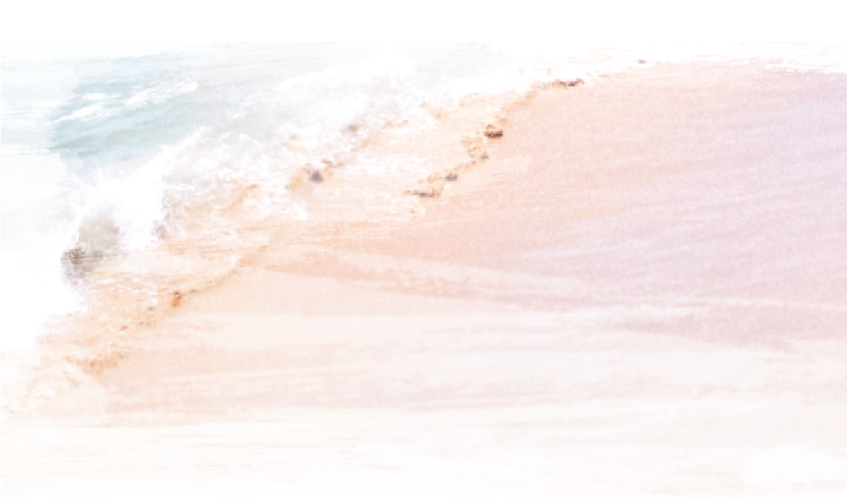Welcome to the Center for Environmental & Urban Studies!
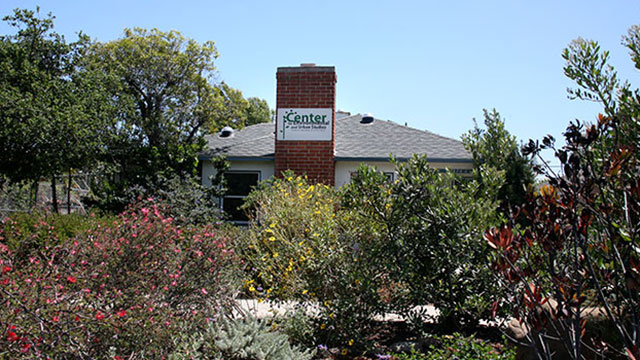
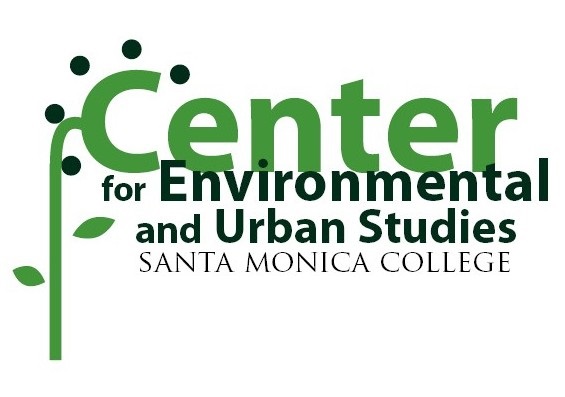 The CEUS was established in 1994 with the help of the Earth Sciences, Social Sciences,
and Life Science departments. It is home to the student greening workshops of Sustainable
Works, student-run clubs, and faculty groups. It provides internships, work study,
professional development, and performs important research for the college’s environmental
programs such as the Environmental Audit, Clean and Green campaign, and most recently
the Greenhouse Gas Inventory. It provides students, faculty, and staff a place to
connect their actions toward broader policy initiatives and build a community around
environmental interest.
The CEUS was established in 1994 with the help of the Earth Sciences, Social Sciences,
and Life Science departments. It is home to the student greening workshops of Sustainable
Works, student-run clubs, and faculty groups. It provides internships, work study,
professional development, and performs important research for the college’s environmental
programs such as the Environmental Audit, Clean and Green campaign, and most recently
the Greenhouse Gas Inventory. It provides students, faculty, and staff a place to
connect their actions toward broader policy initiatives and build a community around
environmental interest.
Outdoors
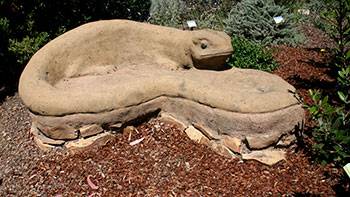 Lizard Bench - is made from cob adobe material and was installed in 2009 by a local permaculture
group. They got the dirt from a local construction site, mixed it with local grasses
and literally stomped it into adobe here in the CEUS driveway. It was designed by
the SMC Art department.
Lizard Bench - is made from cob adobe material and was installed in 2009 by a local permaculture
group. They got the dirt from a local construction site, mixed it with local grasses
and literally stomped it into adobe here in the CEUS driveway. It was designed by
the SMC Art department.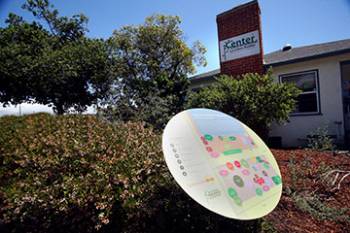 Native Gardens - Installed in the late 1990s by the SMC Botany Department. Maintained by SW volunteers.
Includes only California natives (not only drought tolerant, but native). Supports
local wildlife, requires little maintenance and hardly any water. Some plants are
endangered and all plants have benefits to the local ecosystem like being feeding
local bees, being fire resistant, etc. Organic design fosters an appreciation of the
"wild".
Native Gardens - Installed in the late 1990s by the SMC Botany Department. Maintained by SW volunteers.
Includes only California natives (not only drought tolerant, but native). Supports
local wildlife, requires little maintenance and hardly any water. Some plants are
endangered and all plants have benefits to the local ecosystem like being feeding
local bees, being fire resistant, etc. Organic design fosters an appreciation of the
"wild".Drip Irrigation and Mulch - Installed by the City of Santa Monica in 2009 as a demonstration. Easy to install and maintain. Mulch helps retain moisture and deters weeds and invasive species. We apply mulch twice a year.
Solar panels -
- 3KW system
- Systems will result in reducing emissions over the 25 year warranted life of the modules
by the following amounts:
- 133,650 Lbs. Carbon Dioxide
- 338 Lbs. Nitrous Oxide
- 1,080 Lbs. Sulfur Dioxide
Student Workstation
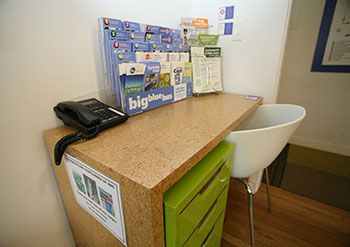 Work/Desk Space - Sunflower seed board/Dakota Burl-is a unique bio-based material, which exhibits
the beauty of traditional hardwood. The material is created from an agricultural fiber
and sunflower hulls making this a great alternative to non-renewable resources. Building
with Dakota Burl reduces the consumption of hardwood trees while utilizing the sunflower
hull after the seeds are harvested.
Work/Desk Space - Sunflower seed board/Dakota Burl-is a unique bio-based material, which exhibits
the beauty of traditional hardwood. The material is created from an agricultural fiber
and sunflower hulls making this a great alternative to non-renewable resources. Building
with Dakota Burl reduces the consumption of hardwood trees while utilizing the sunflower
hull after the seeds are harvested.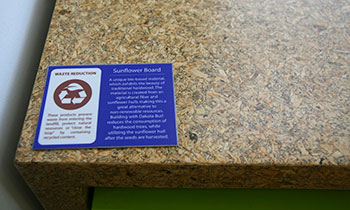 Wheat Board - is created from a rapidly renewable agricultural resource, wheat-straw, which offers
a rich golden alternative to traditional hardwood or paneling products. in addition
to its versatility, wheat board is so environmentally friendly, that the net greenhouse
gas contribution during the life cycle of the product is actually negative.
Wheat Board - is created from a rapidly renewable agricultural resource, wheat-straw, which offers
a rich golden alternative to traditional hardwood or paneling products. in addition
to its versatility, wheat board is so environmentally friendly, that the net greenhouse
gas contribution during the life cycle of the product is actually negative.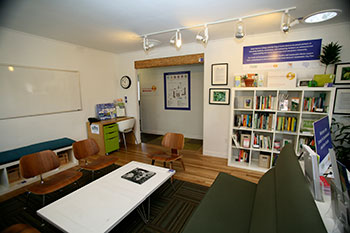 CFLs and Energy Efficient Lighting - The use of one replacement Compact Fluorescent Lightbulb or Energy Star qualified
bulb in every American home would save enough energy to light more than $3 million
homes for one year, more than $600 million in annual energy costs and prevent greenhouse
gases equivalent to the emissions of more than 800,000 cars.
CFLs and Energy Efficient Lighting - The use of one replacement Compact Fluorescent Lightbulb or Energy Star qualified
bulb in every American home would save enough energy to light more than $3 million
homes for one year, more than $600 million in annual energy costs and prevent greenhouse
gases equivalent to the emissions of more than 800,000 cars.Natural Light - The most efficient type of lighting is natural light! Placing buildings in an orientation that maximizes natural day lighting, provides the maximum use of daylight from the east, west and south sides of the home. Maximizing daylight or natural light reduces the need for artificial light, reducing energy consumption and utility bills.
Refinished Hardwood Floors - Refinishing wood floors will reduce consumption of new products, reduce waste, and consume less water and energy since the new wood flooring does not have to be transported. It is definitely a win-win situation. Also, non-toxic soy-based alternative stains and finishes can be used to reduce the chemicals used during the refinishing process.

Energy Star - is a joint program of the U.S. Environmental Protection Agency and the U.S. Department of Energy helping consumers protect the environment and save money through the use of energy efficient products and practices. All equipment in the CEUS is energy star.
Paralam Headers - This product is a manufactured structural wood beam, which is constructed from pressure and adhesive bonded wood strands of wood. Paralam headers actually have a higher strength rating than solid sawed lumber. Use of these headers reduces the demand for new lumber harvesting while strengthening the materials utilized in our house.
CEUS Staff Work Station
Cork flooring - Made from tree bark, it's a natural and renewable resource. Naturally repels pests, is mold resistant. Even cork processing is relatively straightforward: The cork sheets or pieces are cured, boiled and pressed. Scraps are collected for reuse, so almost nothing is wasted.
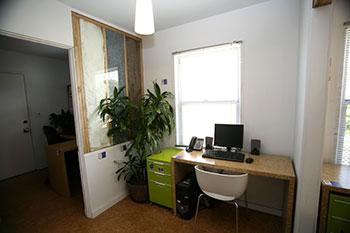 Indoor Plants - The plants in your office or home are not only decorative, but NASA scientists
are finding them surprisingly useful in absorbing potentially harmful gases and cleaning
the air inside modern buildings. Plants that are clean and kept in good condition
have proven to be a real asset in solving the indoor air pollution problem. The top
ten indoor plants ranked for their air cleaning powers are Bamboo Palm, Chinese Evergreen,
English Ivy, Gerbera Daisy, Janet Craig, Marginata, Mass Cane/Corn Plant, Mother-in-laws
Tongue, Pot Mum, Peace Lily, and Warneckii.
Indoor Plants - The plants in your office or home are not only decorative, but NASA scientists
are finding them surprisingly useful in absorbing potentially harmful gases and cleaning
the air inside modern buildings. Plants that are clean and kept in good condition
have proven to be a real asset in solving the indoor air pollution problem. The top
ten indoor plants ranked for their air cleaning powers are Bamboo Palm, Chinese Evergreen,
English Ivy, Gerbera Daisy, Janet Craig, Marginata, Mass Cane/Corn Plant, Mother-in-laws
Tongue, Pot Mum, Peace Lily, and Warneckii.Kitchen & Bathroom
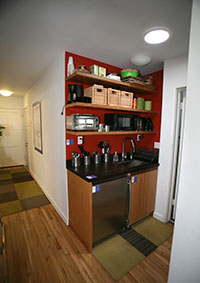 Paperstone Counter Tops - made from post-consumer waste, recycled paper, and proprietary, petroleum-free
phenolic resins. Paperstone is highly UV resistant and has even color distribution
through the entire panel or piece. Paperstone is the "greenest" architectural surface
on the market today. It can be used for interior countertops, wall cladding, conference
tables, signs, windowsills, and toilet partitions.
Paperstone Counter Tops - made from post-consumer waste, recycled paper, and proprietary, petroleum-free
phenolic resins. Paperstone is highly UV resistant and has even color distribution
through the entire panel or piece. Paperstone is the "greenest" architectural surface
on the market today. It can be used for interior countertops, wall cladding, conference
tables, signs, windowsills, and toilet partitions.
Bamboo Cabinets - Bamboo is an eco-friendly choice since it regenerates and reaches maturity in five or six years where it can grow to a height of 80 feet. Bamboo is harder than many hardwoods, swells less, has a high density of fiber, and absorbs less moisture and wears better than hardwood. Use of this product reduces consumption of non-renewable materials.
No VOC paint - Volatile Organic Compounds (VOC’s) are toxins that contribute to the pollution of indoor air, which is one of the top five hazards to human health. New environmental regulations and consumer demand have led to low or zero-VOC paints and finishes. These paints are cost-effective, durable, and less harmful to the environment and people's healths. All the paints in the CEUS are zero-VOC.
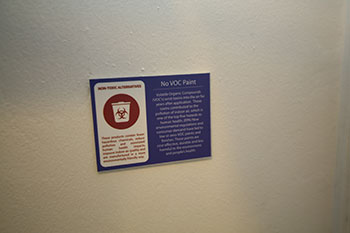 Alternative Chemical Display - Provides education on alternative chemical use.
Alternative Chemical Display - Provides education on alternative chemical use.
Zero Waste - You'll notice that we have very little trash. Due to conscientious behavior on part of our staff and visitors we recycle, compost, or reuse as much as possible.
Reusable Dishware and Cutlery - Allows staff to avoid using disposables and encourages us to bring our meals from home which is cheaper, healthier, and better for the environment.
Water filter - We had a water filter installed that allowed us to discontinue our water service which saves money, water bottles, and Greenhouse gases.
Dual Flush Toilet - The dual flush toilet system is a toilet with two buttons to operate the flush. One button gives a short flush and the other button operates the full flush. The system has the added benefit of using significantly less water, even on the full flush. Most dual flush systems uses less than a gallon for the short flush. This is an amazing saving over the old style toilets where the same flush was made regardless of the actual requirement. The short flush is designed to remove fluids, leaving the long flush in dual flush systems to deal with the flushing away of solids.
Hall Area & Educational Signage
Signage - The goal of the CEUS is to be as interactive and educational as possible. We tried to label and explain all the benefits of our products and processes so that visitors can experience sustainability in action.
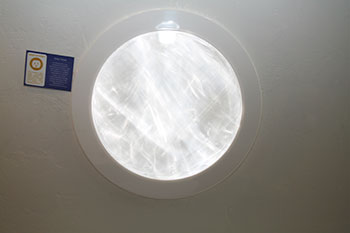 Solar Tubes - Solar tubes capture sunlight on the rooftop of a home or business and redirects
it into the rooms of the homes. Use of this environmentally friendly product has harnessed
"free" energy and has reduced our dependence on manufactured electricity. Three types
installed in the CEUS.
Solar Tubes - Solar tubes capture sunlight on the rooftop of a home or business and redirects
it into the rooms of the homes. Use of this environmentally friendly product has harnessed
"free" energy and has reduced our dependence on manufactured electricity. Three types
installed in the CEUS.
Re-Purposing of Materials - The table is an old door. Basically reusing materials, which could end up in a landfill and eliminating the creation of a new door, less water and energy, etc. Old doors can be repurposed into a headboard, a desk, or a table with relatively easy do-it-yourself instructions.
Living Room
Interface FLOR Carpet Tiles - are manufactured in an environmentally friendly way. The production method produces less waste and does not require the use of heavy adhesives to glue the carpet to the floor. The mission of Interface FLOR is to protect, restore, innovate and educate, with a goal of being 100% sustainable by 2020. During the past 10 years, the company has focused on reducing material waste, financial waste and use of raw materials in their products.

Used Furniture - One of the most environmentally friendly actions we can take is to reuse, reuse, reuse... and furniture is a product that can be utilized by multiple generations. Re-using furniture reduces consumption, water, energy, and non-renewable resources.
Green at All Economic Levels - IKEA (white cubicles) and Herman Miller (green couch) both have strong environmental policies and represent the variety of ways you can incorporate green furnishings into your design. Herman Miller Couch: Fabric is made from recycled water bottles.
Sustainable Works Offices (Patio Area)
Environmental Education Programs:
- Business Greening Program - Helps businesses increase resource efficiency and "green their bottom line". The program is FREE to Santa Monica businesses and will save money and time through increased efficiency and employee education.
- Community Sustainability Program - Facilitates the adoption of sustainable practices in the community and engages diverse stakeholders to meet sustainability goals. This newest program offered by Sustainable Works is managed by the Community Sustainability Liaison.
- Residential Greening Program - Administers the Green Living Workshop where individuals meet once a week for six weeks to learn about concepts of sustainability. The workshops, last an hour and a half and participants learn how to incorporate sustainable practices into their everyday lifestyles, improve their quality of life, and save money while saving resources.
- Student Greening Program - Administers Sustainable workshops at SMC and LACCD where individuals meet once a week for 8 to 9 weeks to learn about
different concepts surrounding sustainability. The workshops last an hour and a half
and participants learn how to incorporate sustainable practices into their everyday
lifestyles, improve their quality of life, and save money while saving resources.
Students in the program can receive extra credit from participating Professors.
- Peer-to-peer discussion format
- Also, have two small worm bins
- Bike blender
- Hoping to increase educational signage program
